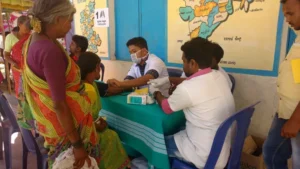Universal Health Coverage in India: Ensuring Healthcare for All
Universal Health Coverage (UHC) in India is a key goal of the government to provide affordable and quality healthcare to all citizens. UHC ensures that everyone receives the healthcare services they need without suffering financial hardship. The Indian government has launched several initiatives, such as Ayushman Bharat – Pradhan Mantri Jan Arogya Yojana (PM-JAY), to improve healthcare access for the poor and vulnerable sections of society.
In this article, we will discuss the importance of UHC, its challenges, government initiatives, and the future of healthcare in India.
Table of Contents
What is Universal Health Coverage (UHC)?
UHC means that all people can access essential healthcare services, including prevention, treatment, and rehabilitation, without financial difficulties. It focuses on:
✅ Accessibility – Ensuring that healthcare services are available to all, including rural and remote areas.
✅ Affordability – Reducing the burden of healthcare expenses on families.
✅ Quality Care – Providing safe, effective, and timely medical care.
✅ Equity – Making healthcare available to everyone, regardless of income or social status.
Importance of Universal Health Coverage in India
- Reduces Financial Burden – Many families in India face financial difficulties due to high medical costs. UHC helps reduce out-of-pocket expenses.
- Improves Public Health – Access to preventive care reduces the spread of diseases and improves overall health.
- Promotes Social Equality – UHC ensures that even the poorest citizens receive quality healthcare.
- Strengthens the Economy – A healthier population leads to increased productivity and economic growth.
- Supports Sustainable Development – UHC is aligned with the United Nations Sustainable Development Goals (SDGs), aiming for a healthier global population.
Government Initiatives for UHC in India
India has taken significant steps toward achieving UHC through various programs and policies.
1. Ayushman Bharat – Pradhan Mantri Jan Arogya Yojana (PM-JAY)
✅ Launched in 2018
✅ Provides ₹5 lakh health insurance per family per year
✅ Covers 10 crore families (50 crore people) from economically weaker sections
✅ Covers hospital expenses, including surgeries, medicines, and diagnostics
2. National Health Mission (NHM)
✅ Includes National Rural Health Mission (NRHM) and National Urban Health Mission (NUHM)
✅ Strengthens primary healthcare services
✅ Focuses on maternal and child healthcare, immunization, and disease control
3. Free Drug and Diagnostics Service
✅ Many states provide free medicines and diagnostic services in government hospitals
✅ Reduces out-of-pocket expenses for patients
4. Health and Wellness Centres (HWCs)
✅ Aim to provide comprehensive primary healthcare
✅ Focus on preventive care, screening, and management of chronic diseases
5. Rashtriya Swasthya Bima Yojana (RSBY)
✅ Provides health insurance coverage for below-poverty-line (BPL) families
✅ Covers hospitalization costs up to ₹30,000 per family per year
Challenges in Achieving Universal Health Coverage in India
Despite several initiatives, achieving UHC in India faces multiple challenges:
- High Out-of-Pocket Expenditure (OOPE) – Many people still have to pay for medicines, diagnostic tests, and private healthcare services.
- Shortage of Healthcare Infrastructure – Many rural areas lack hospitals, doctors, and medical facilities.
- Unequal Access to Healthcare – Urban areas have better healthcare facilities than rural and remote areas.
- Lack of Awareness – Many people are unaware of government health schemes and benefits.
- Low Government Spending on Healthcare – India’s healthcare expenditure is lower compared to developed countries.
Strategies to Improve Universal Health Coverage in India
To achieve Universal Health Coverage (UHC), India needs to adopt several strategies:
✅ Increase Public Healthcare Spending – The government should allocate more funds to the health sector.
✅ Expand Health Insurance Coverage – Ensure that every citizen is covered under a health insurance scheme.
✅ Strengthen Primary Healthcare Services – Improve health and wellness centres (HWCs) in rural and urban areas.
✅ Use Digital Health Technologies – Implement telemedicine and digital health records for better healthcare delivery.
✅ Train More Healthcare Workers – Increase the number of doctors, nurses, and healthcare professionals, especially in rural areas.
✅ Improve Public Awareness – Conduct campaigns to educate people about available healthcare services.
Success Stories of UHC in India
- Tamil Nadu Model – The state has a strong public healthcare system with free medicines and quality medical care.
- Kerala’s Healthcare System – Kerala has high literacy rates and better healthcare indicators due to its focus on primary healthcare and disease prevention.
- Maharashtra’s Health Insurance Scheme – The Mahatma Jyotiba Phule Jan Arogya Yojana provides free healthcare to low-income families.

Future of Universal Health Coverage in India
The future of UHC in India looks promising with the following advancements:
📌 Artificial Intelligence (AI) in Healthcare – AI-based diagnostic tools will improve healthcare efficiency.
📌 Telemedicine Services – Online doctor consultations will make healthcare more accessible.
📌 Ayushman Bharat Digital Mission (ABDM) – Aims to create digital health records for every Indian citizen.
📌 Public-Private Partnerships (PPP) – Collaboration between the government and private hospitals to provide affordable healthcare.
Conclusion
Universal Health Coverage (UHC) in India is essential to ensure that every citizen receives quality healthcare without financial hardship. The government has taken significant steps through initiatives like Ayushman Bharat, NHM, and free diagnostic services, but challenges remain.
To fully achieve UHC, India needs better infrastructure, increased funding, awareness programs, and digital health innovations. With strong policies and public participation, India can move closer to providing healthcare for all, ensuring a healthier and more productive nation













